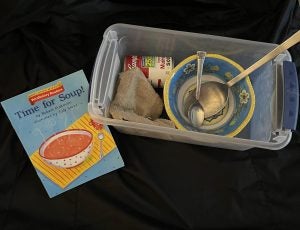How do you teach literacy skills to learners with combined hearing and vision loss?
It requires communication involvement of the reader to learn and experience the book topic and its concepts. You certainly cannot just read a book aloud, show the pictures, and expect comprehension of all concepts in the story. They most likely have limited background knowledge of the topic to make the story’s concepts meaningful. Communication is at the root of all literacy. What is a teacher to do?
Communication and life experiences must be intertwined with literacy activities to make the learning concepts meaningful. Let’s talk about Sam, a middle school student who has combined hearing and vision loss, and has limited physical movement, and is non-verbal. Sam has limited experiences with concept development but he does have life experiences of going to the local fire station since his dad is a firefighter. Sam has developed a love for fire engines and big trucks over the years. His dad has provided him with experiences of sitting in the fire truck and hearing the sounds and seeing the lights up close. Sam always seemed so happy and excited about those experiences. He would turn his head and look towards the sounds and lights. At home, his parents shared that he will independently reach towards a fire truck object when placed on his wheelchair tray. Using this background information about Sam, as a teacher or service provider, how can you help him develop concepts within stories?
Sam’s teacher learned about his interests through staying in touch with his family. She consistently sent a home/school communication folder back and forth each day to share information with the family. The folder kept her informed of potential topic areas as she created communication and literacy opportunities for Sam. The teacher used the topic of fire trucks to create literacy boxes, also called story boxes to help teach other concepts to Sam. She had her ‘hook’ (the fire trucks) and used it to develop a variety of learning concept activities because she knew that Sam would be a captive audience. One of the books she used was My Fire Engine by Michael Rex.
As the teacher selected the book, she wondered how she could address concepts using tactile and auditory means. How could he access the book himself since he was unable to hold the book and turn the pages? A story box was the answer! Story boxes are collections of objects directly related to the story that make the reading event more interactive for those who may not benefit as much from viewing pictures on the book pages. The objects become the pictures for the learner who has vision loss. There are lots of storybook options available that use predictable text and/or have rhythm. Using items that are within the child’s frame of reference and interest area increases interaction in the story.
Create your own story box by following these steps:
- Find a book that would be of high interest with a limited amount of vocabulary on the pages. If the story you have chosen has too much vocabulary, you can adapt and make smaller sentences with two- four words to shift the focus to the concept you want to address.
- Add Braille to the pages and guide the student to explore the print.
- Create a box of items that coincide with the story. You can use items around the house that you may already have. For example when using the My Fire Engine story, gloves, jacket, hat, spray bottle with water, etc. can be added to a box of items to go along with the story.
- Explore the objects in the box prior to reading the story. Share information with the learner about the object’s details, such as shape, texture, size, etc. It’s also helpful to act out the proper use of the object. For example, if it is a glove, try it on. Compare the items based on the details.
- After exploration, move objects to the side. Read the story and present the objects as they are introduced in the story. Once you’ve completed the story, have the child assist placing the items back in the box. In addition to providing another opportunity to explore the item, placing the items back in the box assists with helping the child to understand that the story is finished.
The options for creating story boxes are endless! Have you created any for your students? If so, please share your ideas!
Julie Brickhouse, M.Ed., NBCT, East Carolina University DeafBlind Project Teacher Support Program, Technical Assistance Consultant


